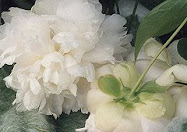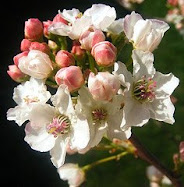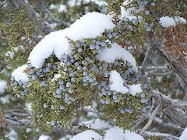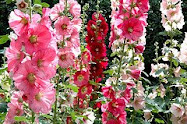 The bulbs put into the ground for the fall planting season over the last couple weeks: dark purple Dutch iris; windflower anemones; double-blossom mixed yellow and white narcissus; cherry vanilla double-blossom tulips; Thalia snow-white narcissus; and hyacinths. All these bulbs enlarge upon the existing colonies of their species already in place in the garden, building its repertoire for a broader, bolder and longer yield next spring. The anemone and tulip bulbs, which are to deer, rabbits and squirrels what hot fudge sundaes are to the gardener, once placed in the ground and before covering over, got sprayed to soaking wet with garlic and egg liquid deer repellent, to improve their chances of staying in their beds and not being precipitously dug up for a critter dinner.
The bulbs put into the ground for the fall planting season over the last couple weeks: dark purple Dutch iris; windflower anemones; double-blossom mixed yellow and white narcissus; cherry vanilla double-blossom tulips; Thalia snow-white narcissus; and hyacinths. All these bulbs enlarge upon the existing colonies of their species already in place in the garden, building its repertoire for a broader, bolder and longer yield next spring. The anemone and tulip bulbs, which are to deer, rabbits and squirrels what hot fudge sundaes are to the gardener, once placed in the ground and before covering over, got sprayed to soaking wet with garlic and egg liquid deer repellent, to improve their chances of staying in their beds and not being precipitously dug up for a critter dinner. The garden has three large round mats of dianthus plantings which have increased their diameter annually and resemble a plush green carpet all spring, summer and fall. They're aged approximately four to five years, and this past spring, for the first time, produced only a scant smattering of flowers during bloom time in late May and June. With these, and the creeping phlox whose spring display also was diminished this year, composted cow manure was dug into their root stock and layered around their crowns. Hopefully the fresh, rich soil will feed them up over the winter sufficient to bring back their profuse bloom habit.
After cutting down the yellowed, floppy leaves of the Siberian iris and daylillies, the long leaf blades were sheared into lengths of three inches or so, and layered back around the plant cores. Thus do the leaves get put to use as green mulch, warmth, and protection to the soil and plant roots from erosion by the rains, or freezing and thawing and heaving from winter temperature fluctuations. The chrysanthemums, some of which are still doing their beautiful work of fall flowering, are not going to be cut down to the ground this year. Several gardening professionals have mentioned in recent writings that mums do better through winter in cold climates with their leafy, woody stems left intact to shelter the plant crowns from the weather. As they finish flowering, I snip off the dead flower heads, and trim the leafy torso of the plant down only half way, leaving it three or four inches above ground until next spring's advent of more gentle fahrenheits.
Other trimming, tidying up is ongoing, but the bulbs no doubt mark the last gardening (as in actually planting something) to be done this year. There is an old saying that one can bury a lot of troubles by digging in the dirt. Certainly that is true for me, heaven knows the soil of my garden is laden deep and wide with truckloads of troubles, worries, melancholia, and fears worked out and into it over the years. Gardening is the most potent, immediate and efficacious treatment for unhappiness I've ever come across. Getting the hands dirty out of doors and sowing possibility and hope, witnessing and tending to the physical fruits of one's labor, beats the pants off any pharmacopoeia or counseling on offer to the sore of heart. And so it is with sadness and feelings of dread that the gardener downs tools and watches the inexorable advance of the season of dormancy and death across the meadows, hills and forests.
The trees are emptying of leaves, autumnal gales and rainstorms rudely tumble the afternoons away. Frost falls down at night, the sun offers only a cold shoulder to the days. Any gardener who claims to like the wintertime is surely, at the least, disingenuous. Yes, the woods boast wonderful hot-coal colors in late October, shiny chestnuts and sweet, beanie-capped acorns can be gathered, but to the gardener, all this brown, gold and flame-orange means death is coming creeping, gnawing relentlessly away at the green, the alive. As autumn marches on toward a frozen, still-life tomorrow, the gardener can do nothing except bundle up self and garden against the walloping cold a northwestern Michigan winter invariably delivers.
Preparing the garden to withstand the slings and arrows of another winter, and laying in bulbs to better clothe it in resplendent color and output next spring, hasn't been enough, this year, to tranquilize my discontent and woe that summer is finished, another year of gardening has ended, winter is nigh. The turning of the seasons is part and parcel of living in a northerly climate, and necessary to the existence of many of my favorite garden dwellers – the lilacs, the peonies, the forsythia and high bush cranberry. And yet, and yet, maybe it's the too short, too cool summer we were allowed this year; maybe it's the bittersweet knowledge that the penny-candy pink and pale apricot mum flowers sitting so prettily in china jugs on my tabletops are the very last flowers I will be able to cut from the garden this year; maybe it's that the top third of the quaking aspen tree has already been burgled of all leaves by the windstorms, even as the leaves hold their shimmering gold final fling with color – but I do not, this year, go gladly into the long garden goodnight of winter. I don't want it, I don't like it. I go to the Lake Michigan shore, take off my moccasins, and wade defiantly up to my knees in its pellucid 50-degree waters. I contemplate going for another swim (insane idea), and exhort the temperature gods to go against all odds and rise, rise.
It will probably take nothing short of the first big blizzard to put a halt to this feckless, childish, contrary behavior. Until those furbelows of snow come swooping into the garden, the gardener will probably persist in impotent resistance to Mother Nature's procession down the ancient, necessary pathways of the seasons, in all their tempests, wisdom and power.









